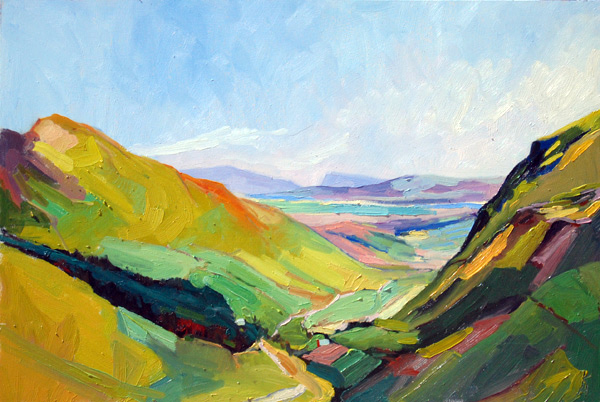Glengesh Pass is a glacial cut between the Mulmosog and Glengesh mountains near Ardara in Donegal, Ireland. There is a scenic lookout at the southwestern end (the top) of the pass. From there the road steeply zigzags down to the valley below.
Glengesh Pass No. 2 was completed from several watercolors painted from the scenic lookout at the top of the pass in late morning. The note on my watercolor said “more yellow”. At the time I could not get the watercolor pigment to be as bright or as yellow as I wanted, but with the opaque oils I have more control over the intensity of the pigment.
My favorite times to draw and paint at the pass were in the morning or evening when the sun kissed the hillsides and cast deep shadows in the valley. The heather and gorse growing on the rocky slopes turns the hills to lavender and gold. The crumbling stone walls that criss-cross the steep slopes become more visible because of the shadows they cast. On rainy days the mountains are lost in the mist and the valley floor seems cut off from the world.
The Glengesh pass also hold a very special memory of a perfect moment for Jim and me:
It was late at night under a huge full summer moon. We were driving from Ardara to our accommodations on the other side of the pass. The radio reception on the car stereo was going in and out as we drove through the mountains. Our little blue car — a VW Lupo powered by a engine more suited to a lawnmower, could barely manage the steep pass. The pass's narrow road zig-zags up the mountain with shear drop-offs into the valley below. The car kept stalling and rolling back. We could not get enough power to make it up the hill. We would get about 20 feet up the incline, stall out and begin rolling back, with Jim trying to steer and brake so we would not plunge backwards off road to the valley floor 500 feet below. Jim finally got the car moving and floored it so we could get enough power to get up the mountain. We were shouting words of encouragement to the car as it sputtered and chugged slowly upwards. As we finally cleared the steepest part of the climb, the radio suddenly buzzed back into clarity with 1920's hot jazz music. As we crested the mountain we wondered at that perfect moment, when we realized we were not going to die in a horrible wreck at the bottom of the pass and how gorgeous the moon and stars were as we looked up the steep sides of the pass into the night sky above the mountain top — all choreographed to King Oliver's Creole Jazz Band. We wound our way along the lane out of the mountains and through the bog as the music ended and the announcer gave the day’s hurling scores in Irish (Gaelic).



